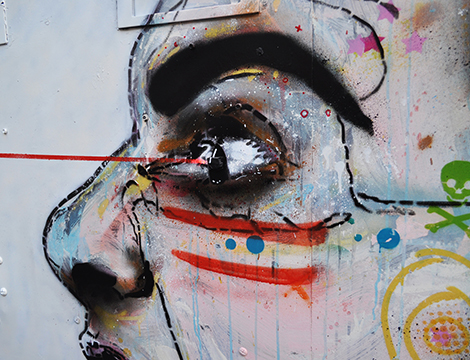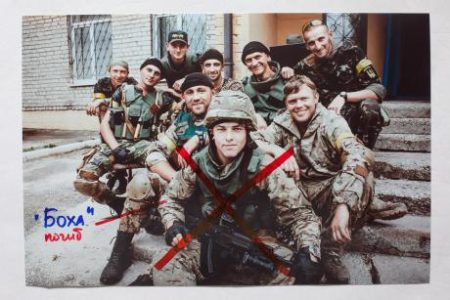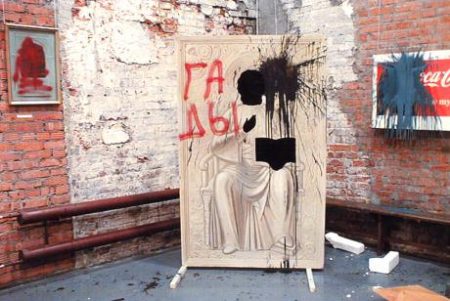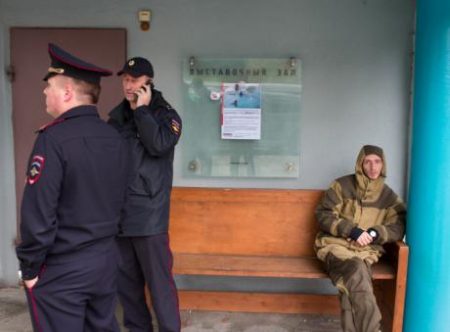
This article was originally published by the openDemocracy on 30 September 2016.
Amid Russia’s conservative turn, a new brand of conservative civil society is mobilising against freedom of expression. Русский
Anton Belikov walks through the Direct Look exhibition, and attacks work by Sergei Loiko and Alexander Vasukovich. Video: Elena Balakireva.
On Wednesday evening, Anton Belikov, an artist and lecturer at Moscow’s Surikov Academy of Arts, walked through an exhibition of photographs documenting the war in eastern Ukraine, and threw paint over them. Having ruined and torn up the pictures as “war propaganda”, Belikov then turned to one of the photographers and the curator to say: “You wanted civil society? Well, now you’ve got it.”
These photographs by photographer Alexander Vasukovich and journalist Sergei Loiko were exhibited in Moscow’s Sakharov Center as part of the Direct Look photography prize. As a result of this attack, the Sakharov Center decided not to close the exhibition, but instead to hang posters detailing what took place on 28 September in place of the damaged works.
That wasn’t the end of it, though. On Thursday morning, “Cossacks”, veterans from the Donbas conflict and a municipal deputy occupied the exhibition centre and destroyed these posters, too. They also presented the Sakharov Center with a jar of fake blood, “to symbolise the blood of children who had died in the conflict”.
Indeed, it’s been a bad week for artistic freedom in Moscow. A few days before, the Lumière Brothers’ Center for Photography closed “Without shame”, an exhibition by American photographer Jock Sturgess. Civil society also made a show of force here — in the form of some tough guys from the Officers of Russia organisation. The officers demonstrated against Sturgess’s “paedophilic” photographs, blocking the entrance to the gallery.
Although both parties later reconciled, the exhibition was closed down. The management of the Lumière Center even thanked Anton Tsvetkov, the leader of the Officers of Russia, as the only “public figure” that who “dealt with everything and was able to intelligently discuss the situation at hand.”
Never before in today’s Russia has the status of “public figure” carried such weight. A public figure cooly and wisely resolves a conflict. Meanwhile, the actual nature of the conflict is forgotten — to the delight of the champions of morality. What does it matter how and why Sturgess’s exhibition was closed down? Was it because the Officers of Russia blockaded the entrance to the gallery, or because their leader advised that it be closed due to a “concern for safety”?

What’s most important is that these ever-indignant and ever-watchful citizens got their way. A private gallery apologises and expresses its thanks to a “public figure”. Even though Tsvetkov even admitted that Sturgess’s exhibition displayed “no work that violated Russian law”, Russia’s Civic Chamber, a body that provides oversight from public figures on state matters, then declared that the “public display of artists’ work should be discussed beforehand by a special commission, including experts such as art critics and people who have the proven ability to assess works of art.”
This would appear to be a celebration of the very highest ideals of civil society. Indeed, there’s no reason to doubt that such a commission would enjoy authority and the widest possible support. Through the dispute over Sturgess’s exhibition, the status of the Civic Chamber (and its officially recognised public figures) as arbiters in ideological conflicts has risen once again.
The criminal nature of the vandalism against Loiko and Vasukovich’s photographs no longer features in public discussion. It’s simply the “protest of concerned citizens”. We have witnessed a highly effective operation legitimising conservative — both clerical and secular — civic activism in Russia.
How I would love to believe that the Civic Chamber and its regional counterparts is the mere imitation of the non-commercial and non-government organisations that exist only at the Kremlin’s will. How I wish that the “Orthodox activists” and protectors of the secular realm who began to openly confront the very principle of freedom of expression after Pussy Riot chanted “mother of God, drive Putin away” during their (brief) invasion of another’s territory at the Cathedral of Christ the Saviour.
No, this confrontation began much earlier. Back in 2003, “Orthodox activists” attacked the “Danger, Religion!” exhibition held in the Sakharov Center. They destroyed part of the exhibits, but the court nonetheless acquitted them. In those days, it seemed like a conflict between church activists and marginal leftists, which Russian mainstream media deemed simply an unfortunate incident.

It’s become obvious that this was the first manifestation of a conservative turn which has now gripped all of Russian society. This turn was not simply decreed from on high, and was enabled by more than the country’s domesticated mass-media. Activists who go to galleries and theatres and force them to close are backed by popular support, even if it’s not always obvious.
They are active in every corner of the country. The well-known Dmitry Enteo, Cossacks and “Orthodox activists” harass museums, theatres, the contemporary arts centre Vinzavod, and, of course, Moscow’s Sakharov Center. They’ve had other successes: from the banning of the opera “Tannhäuser” in Novosibirsk to the cancellation of concerts by the Polish rock band Behemoth in Krasnodar and Vladivostok. There are dozens of similar cases across the country.
Conservative activists benefit from the indifference of that section of society which prioritises “stability” above all, and renounces its own political interests. They triumph thanks to a lack of solidarity between liberals and leftists working in the arts and media. They go after the most vulnerable institutions of freedom of expression — modern art and those NGOs which the government has declared “foreign agents”.
The state, watching these conflicts from far above, can then quote the words of our spray-can philosopher: “You wanted civil society? Well, now you’ve got it”.
In the past decade or so, the Russian government has created a representative structure for these “public figures” in the form of the Civic Chamber, gave them funding for their own “NGOs”, while kicking out critical foundations and international organisations. At the start of the 2000s, when the Kremlin’s cat-and-mouse game with the non-governmental sector had only just begun, NGOs appeared to be something innocent — exotic, even. Many of the old human rights organisations readily embraced the process of everyone unifying together across ideological and organisational divides. (“What’s wrong with the regional association of beekeepers. Why not enter into an alliance with them?”)
In those days it seemed that a union, say, between human rights defenders and the “beekeepers” would help avoid polarisation and allow greater possibilities when lobbying for civic initiatives. However, this union of “everybody” with “everybody else” was decreed from above. Any NGO working outside the state or mainstream organisations were soon doomed to failure. The result is a stronger polarisation than ever before. The “beekeepers” get their municipal funds and presidential grants, while human rights defenders are forced to the very margins of Russia’s public consciousness.

Thus, this most conservative, even aggressively intolerant section of Russian society has learnt to master those tools of civic activism which had earlier been the preserve of leftists and liberals — everything from protests, social media and street art to “Occupy”. It once seemed that there were spheres of civic life immune to conservative radicalism. But no longer.
Of course, the arts will bear the brunt of this conservative turn — both the visual and the theatrical. The propaganda of “traditional values”, repression of the public sphere and crisis in education have all strengthened the Soviet-era belief that art must be clear, immediately accessible and, crucially, without conflict.
Everything beyond these boundaries appears dangerous — something which undermines the very foundations of society. One of the greatest hazards is to enter the aggressive and loaded debate about the “war” started by Pussy Riot or Pyotr Pavlensky against these traditional values. Are you for or against it? Why don’t you support the publicly-minded, principled protests of Anton Belikov or Dmitry Enteo, which are expressed in “artistic performances”?
The events surrounding these two photo exhibitions this week are the natural result of a fierce and relentless attack on freedom of expression. Now this war is waged not only by the state, but by a group of very, very concerned citizens.
About the author
Mikhail Kaluzhsky is Lead Russian-Language Editor at oDR. He is the author of Music Repressed (2007) and many documentary theatre projects. He can be found on Twitter via @kaluzhsky.
This article is published under a Creative Commons Attribution-NonCommercial 4.0 International licence.
For more information on issues and events that shape our world, please visit our CSS Security Watch Series or browse our Publications.

